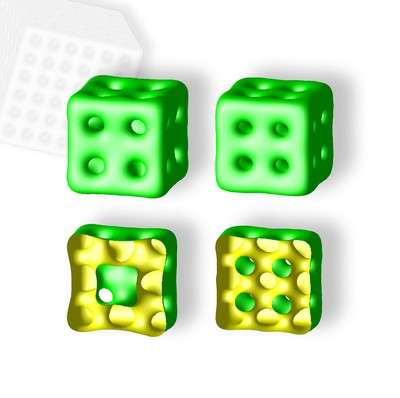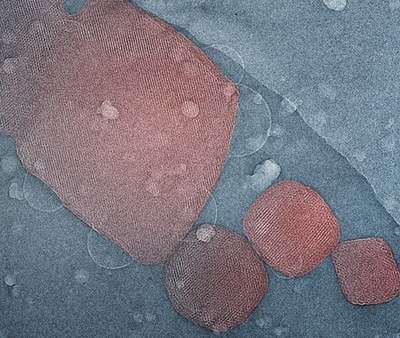The strange interiors of nanoscale cubosomes

Under certain conditions, appropriately selected particles can form closed surfaces in liquids with surprisingly complex shapes, cutting through space via a regular network of channels. Advanced theoretical modelling carried out at the Institute of Physical Chemistry of the Polish Academy of Sciences in Warsaw has allowed researchers to look into the interior of cubosomes, spectacular three-dimensional nanostructures, for the first time.
At first sight, it's difficult to resist the impression that they've been designed by an engineer-perfectionist, and not nature itself. Nanocscale cubosomes have a shape that is generally cubic, riddled with holes as regular as windows in a block of flats. The sizes of cubosomes range from tens to hundreds of nanometres. So far, they have been studied mainly using electron microscopes, which made it possible to describe their external shape. However, none of the currently available experimental techniques have penetrated in detail the interior of these remarkable structures.
"Where the experimenter cannot go, he sends the theorist. An effective way to see inside cubosomes proved to be theoretical modelling using computers. Our numerical calculations revealed that the internal structure of cubosomes may be much more complex than originally thought," says Dr. Wojciech Gozdz from the Institute of Physical Chemistry of the Polish Academy of Sciences (IPC PAS) in Warsaw.
Cubosomes are similar in structure to crystals—like crystals, cubosomes express a repeating basic building block, referred to as the unit cell, which can be distinguished. However, that's where the similarity ends. In crystals, the unit cell consists of a group of typical and always equally spaced atoms or molecules, whereas in cubosomes it is a section of appropriately formed membrane immersed in water.

"Cubosomes can be constructed from a variety of unit cells corresponding to different cubic structures. A single cubosome composed of such single cells somewhat resembles a sponge. Sponges, however, have a chaotic internal structure, whilst in cubosomes it is very, very regular," says Dr. Gozdz, adding, "A cubosome can be imagined as a closed surface. A simple example of a closed surface is a torus. However, in a torus there is only one hole, while in cubosomes, there are typically from several tens to several thousands of holes."
Under the appropriate conditions and employing the appropriate experimental procedures, cubosomes form in a liquid medium containing amphiphilic molecules—that is, molecules in which one end is hydrophobic (water aversive), and the other is hydrophilic (water attractive). In water, amphiphilic molecules can form a double layer (bilayer) constructed in such a way that the hydrophilic ends are on the outside of the layer and the hydrophobic ends are directed towards its centre. Cubosomes can also be formed in ternary liquids, consisting of water, oil and amphiphilic molecules. The molecules then form not bilayers but monolayers, with their hydrophilic ends directed towards the water and hydrophobic ends toward the oil.
The three-dimensional membrane creating each cubosome is closed and riddled with a regular network of tunnels. The tunnels are filled with the liquid in which the cubosome is immersed. If the solution in which the cubosome developed was two-component, the space in the cubosome enclosed by the membrane will be filled with the same liquid (in a ternary solution it would be a liquid other than that in the tunnels). Therefore, each cubosome can also be treated as a regular, three-dimensional grid of channels filled with a liquid (or two liquids). Thus perceived, the cubosome becomes a crystalline structure formed of liquid 'bars' surrounded by amphiphilic molecules.
In his research, Dr. Gozdz focused on cubosomes made of bilayers, since such systems have been studied experimentally and in the future, may have many uses as drug delivery vehicles. Earlier, attempts to describe the shape of nanoparticles of this type used artificially matched mathematical functions. At the IPC PAS, a model built on physical equations has been used for first time to investigate the structure of cubosomes. The results of numerical calculations have led to some interesting discoveries.
"We noticed, for example, that the size of the unit cell in cubosomes may be different from the size of the single unit cell in the solution. Indeed, cubosomes may swell or shrink in order for the resulting structure to have the least energy. If the size of the unit cell inside the cubosome remains the same as in the solution, then the cells adjacent to the walls of the cubosome may be significantly deformed," says Dr. Gozdz.
The research at the IPC PAS has led to an even more surprising conclusion. Two cubosomes that are virtually identical externally can have a greatly varying internal structure. This observation is of important practical value due to one of the most important potential applications of cubosomes: the delivery of drugs in the body. Currently, liposomes are used for this purpose (these are spherical vesicles whose membrane is formed by a lipid bilayer). Compared to liposomes, cubosomes have a much richer, less uniform internal structure. A drug introduced into the cubosome's three-dimensional network of channels would be released for a longer period of time and in more precisely controlled doses. Therefore, the ability to change the internal structure of cubosomes without exerting a significant influence on their exterior dimensions and shapes, discovered at the IPC PAS, opens the way to precise manipulation of the rate of release of drugs.
Provided by Polish Academy of Sciences



















